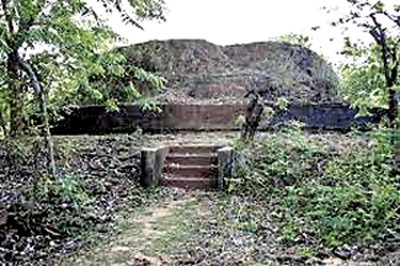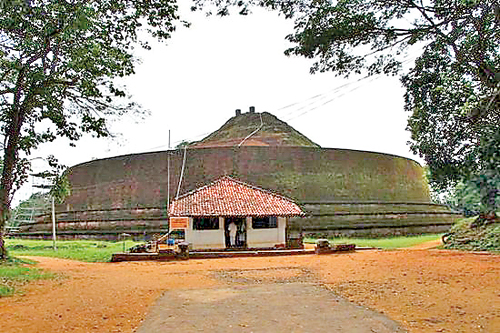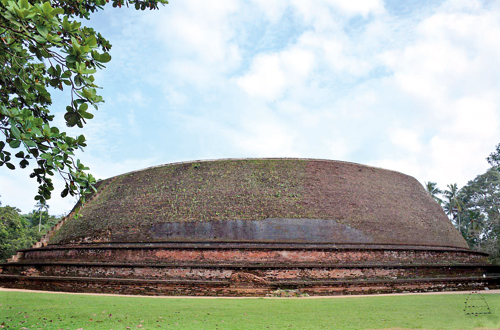Reign of Parakramabahu and three mounds of mystery

Demala Maha Seya
The pilgrim to Polonnaruwa generally overlooks the small track that meanders to the jungle just before Thivanka Pilimage, where a giant ruined Buddha image lingers in the vaulted semi darkness. An Archaeology Department board indicates the small path that leads to the Demala Maha Seya, yet few searchers go after it.
But if you so choose to, this ignored path puts you on the trail of an archaeological enigma.
Walking through dry scrub you arrive at the foot of what resembles a large earthy hill. Or so it was thought until it was realized to be what is left of a stupa- a structure so gigantic that if completed, it would have been the biggest stupa in the world.
An aerial photo illustrates splendidly how the stupa had been hidden in plain sight- its giant upside-down bowl-like shape clothed in jungle rising from the ancient wooded plains.
But the stupa does not stand alone. It has two far-flung twins, one in faraway Dedigama and the other in wild Yudanganawa in Uva, all three complete enigmas because of their size and shape.
According to Prof. Malinga Amarasinghe, Professor of Archaeology at the University of Kelaniya, Parakramabahu I (1153-1186), that most ambitious monarch, is credited with building these colossuses to mark three milestones in an epic life.
The Demala Maha Seya now retains nothing of its original fabric, other than remains of the pesa walalu (the concentric perimeter rings) and a second small stupa on top.

Yudanganawa
Folk etymology has been quite busy with the intriguing moniker ‘the Great Tamil’ stupa, some claiming it was the derivation simply of ‘demahal seya’ or the two-storeyed stupa. But given that the other stupas of this type all have the crowning dwarf stupa on top, the theory somewhat
loses ground.
Other legends claim the stupa was built to be seen in India, or by Tamil slaves brought over by Parakramabahu.
Prof. Amarasinghe says that, given its massive girth (someone circumambulating it will have to walk more than 650 metres) the stupa is short at a height of 25 metres. Those who believe it is uncompleted say if finished it would have been 190 metres tall. The old name for the stupa has been Unagala Vehera, and more will only be revealed with further excavations.
The second stupa, the Dedigama Kota Vehera looms by the road at Nelundeniya, not that far from Colombo.
Though smaller than the Polonnaruwa monument, this is the best preserved stupa of this type. The name Suttighara Caitya denotes this was the birthplace of Parakramabahu, and the location is the historic Punkagama.
A small stupa on top is thought to have been built enclosing the vadum-ge (royal birthing place) where the prince, then son of regional adipada ruler Manabharana, was born.

Dedigama
The kota vehera, 78 metres in diameter and 14 metres high, proved to be a treasure trove for the antiquarian, with no less than ten separate relic chambers. In these were found Buddha images in gold and silver, precious stones, coins, jewellery, bangles, small sculpted quails in gold and reliquaries in gold and silver. The chambers were also painted.
The most spectacular find was the ath pahana or elephant lamp, an intricate work of art and a medieval engineering feat.
The third stupa, the Yudanganawa is in ancient Ruhuna country. One of the biggest stupas in Sri Lanka, its name links it to the site of the battle between the royal brothers Gamunu and Tissa in the Anuradhapura period.
But the importance for Parakramabahu was that the site marks the cremation of Queen Ratnavali, his mother. The old name for the site was Beeragama.
The smaller stupa on top of this stupa is quite pronounced.
The central enigma concerning the three stupas is of course, their shape and size. It seems hardly logical to say all three (with their peculiar identical features) were left uncompleted, given that their creator was a prolific monarch who did nothing by halves, and was fastidious about his reputation.
The stupas could, then, be built in a special style. Was it the hitherto unknown padmakara (lotus shaped), with a giant lotus shaped superstructure now gone? Or was it a style the rather cosmopolitan Parakramabahu had picked up from a foreign land? Many are the enigmas that shroud the mounds.
They are emblematic of just how much island history, even despite the lofty chronicles we possess, remains unknown- as silent and tantalizing as the sleeping landscape that can suddenly awake.


